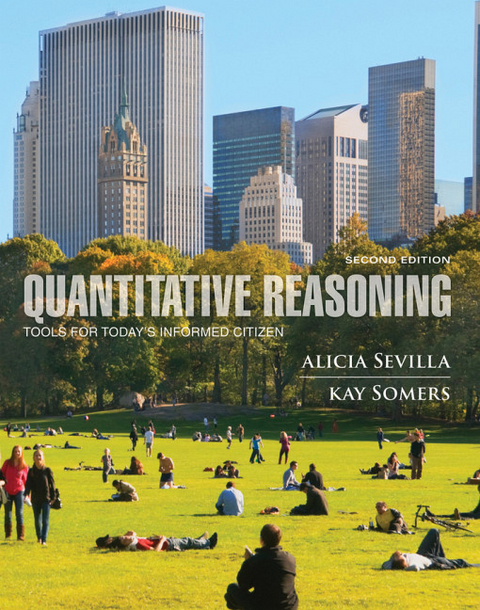
Quantitative Reasoning
John Wiley & Sons Inc (Verlag)
978-0-470-59271-7 (ISBN)
Sevilla and Somer's Quantitative Reasoning, 2nd Edition comes available with WileyPLUS, a research-based, online environment for effective teaching and learning, which takes the guesswork out of studying by providing them with a clear roadmap: what to do, how to do it, and whether they did it right.
WileyPLUS sold separately from text.
Alicia Sevilla has a Ph.D. in mathematics from Cornell University and is Professor of Mathematics at Moravian College, where she has taught for over 20 years. She participated in the two FIPSE projects that produced the COMPANION TO CALCULUS and mentored other institutions to adopt the integrated approach. She recently served as Chair of the Department of Mathematics and Computer Science, and was co-director of a National Science Foundation grant to develop and implement a quantitative reasoning course. She is an active member of the Mathematical Association of America, and serves as Coordinat.
Annotated Contents xi
Preface xvii
To the Student xxiii
To the Instructor xxv
Acknowledgments xxvii
Section I: Numerical Reasoning
Topic 1: Organizing Information Pictorially Using Charts and Graphs 2
Activity 1.1: World Motor Vehicle Production: Bar Graphs and Pie Charts 27
Activity 1.2: Medical Data and Class Data: Graphs with Excel 35
Activity 1.3: SATs and the Super Bowl: Creating and Interpreting Histograms 43
Topic 2: Bivariate Data 52
Activity 2.1: Estimating Dates: Scatterplots 69
Activity 2.2: State Governors’ Salaries and Per Capita Income: More on Scatterplots 75
Topic 3: Graphs of Functions 82
Activity 3.1: Temperature Patterns: Functions and Line Graphs 105
Activity 3.2: Rates of Change and Concavity 111
Topic 4: Multiple Variable Functions 118
Activity 4.1: Blood Alcohol Levels and Credit Cards: Working with More Than Two Variables 133
Topic 5: Proportional, Linear, and Piecewise Linear Functions 140
Activity 5.1: Rates of Change and Linear Functions 159
Topic 6: Modeling with Linear and Exponential Functions 166
Activity 6.1: The Genie’s Offer: Exponential Growth and Linear Growth 185
Activity 6.2: Lines of Best Fit 191
Topic 7: Logarithms and Scientific Notation 198
Activity 7.1: Richter Scale and Logarithms 213
Activity 7.2: Estimations, Scientifc Notation, and Properties of Logarithms 219
Topic 8: Indexes and Ratings 224
Activity 8.1: Measurement Difficulties and Indexes 243
Activity 8.2: Consumer Indexes 249
Topic 9: Personal Finances 256
Activity 9.1: Mortgages 277
Topic 10: Introduction to Problem Solving 284
Activity 10.1: Savings and Loans: Problem Solving and Using Scroll Bars 299
Activity 10.2: Asking and Answering a Research Question 305
Section II: Logical Reasoning
Topic 11: Decision Making 308
Activity 11.1: Ranking Cities: Ratings and Decisions 325
Topic 12: Inductive Reasoning 332
Activity 12.1: Analyzing Studies: Inductive Reasoning 345
Topic 13: Deductive Reasoning 354
Activity 13.1: Code-Breaking and Deductive Reasoning 375
Activity 13.2: Compound Statements Used in Reasoning 381
Activity 13.3: Quantified Statements and Deductive Reasoning: Direct and Indirect Reasoning 389
Topic 14: Apportionment 394
Activity 14.1: Methods of Apportionment: Quota Methods 409
Activity 14.2: Apportionment: Divisor Methods 415
Topic 15: More on Problem Solving 422
Activity 15.1: Making a Purchase Decision 433
Section III: Statistical Reasoning
Topic 16: Averages and Five-Number Summary 436
Activity 16.1: Visualizing Football Scores: Measures of Center and Spread 457
Topic 17: Standard Deviation, z-Score, and Normal Distributions 462
Activity 17.1: Coins, Presidents, and Justices: Normal Distributions and z-Scores 485
Topic 18: Basics of Probability 492
Activity 18.1: Simulations 511
Activity 18.2: Finding Probabilities 517
Topic 19: Conditional Probability and Tables 522
Activity 19.1: Diagnostic Testing and Conditional Probability 543
Topic 20: Sampling and Surveys 550
Activity 20.1: Sampling and Surveys 569
Topic 21: More on Decision Making 578
Activity 21.1: To Purchase a Warranty or Not: Making a Decision 593
Appendix
Excel Commands by Activity 597
Index 603
| Erscheint lt. Verlag | 26.5.2017 |
|---|---|
| Verlagsort | New York |
| Sprache | englisch |
| Maße | 201 x 257 mm |
| Gewicht | 1247 g |
| Themenwelt | Geisteswissenschaften ► Psychologie ► Allgemeine Psychologie |
| Mathematik / Informatik ► Mathematik ► Allgemeines / Lexika | |
| ISBN-10 | 0-470-59271-0 / 0470592710 |
| ISBN-13 | 978-0-470-59271-7 / 9780470592717 |
| Zustand | Neuware |
| Haben Sie eine Frage zum Produkt? |
aus dem Bereich


